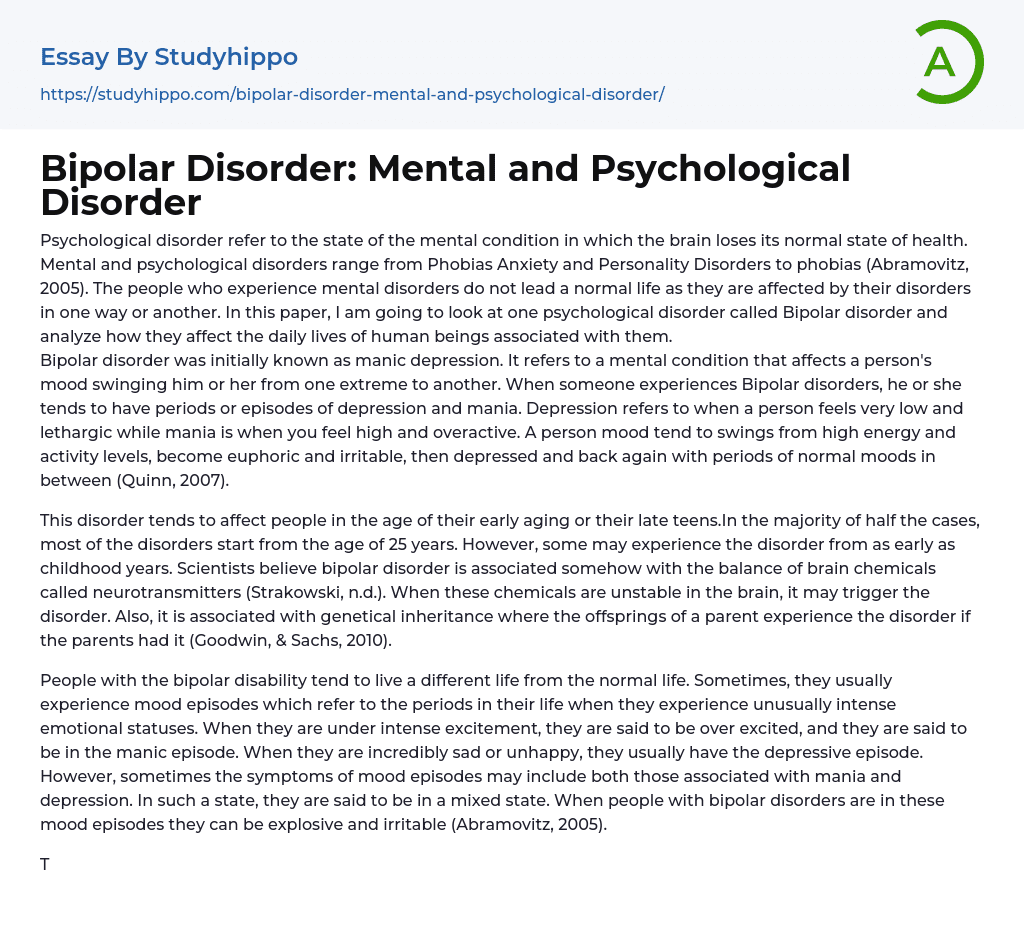

Bipolar Disorder: Mental and Psychological Disorder Essay Example
Psychological disorders, or mental disorders, are deviations from the brain's usual state of well-being.
The article discusses various mental and psychological disorders, such as Phobias, Anxiety, Personality Disorders, and other conditions (Abramovitz, 2005). People dealing with these disorders encounter daily difficulties that affect their lives. In particular, this article focuses on Bipolar disorder, formerly known as manic depression. This disorder involves drastic shifts in mood between high and low states. The study will explore how individuals impacted by this disorder manage its consequences in their everyday lives.
Bipolar disorders, marked by alternating periods of depression and mania, are characterized by low mood and lethargy during depressive episodes and high energy and hyperactivity during manic episodes. These mood swings can range from feelings of euphoria and irritability to depression, with intermittent periods of normal mood in between (Qu
...inn, 2007). The disorder typically begins in early adulthood or late teenage years around age 25, although some individuals may experience it during childhood. Scientists believe that the disorder is linked to neurotransmitter balance, which refers to brain chemicals (Strakowski, n.d.).
The potential initiation of bipolar disorder can be attributed to the instability of specific chemicals in the brain. In addition, inheritance plays a role, as individuals are at a higher risk of developing the disorder if their parent has it (Goodwin, ; Sachs, 2010). Those with bipolar disorder experience distinct lifestyle and periodic mood episodes characterized by intense emotional states. These episodes can manifest as either manic or depressive, with manic episodes displaying excessive excitement and depressive episodes inducing profound sadness.
When individuals with bipolar disorders have mood episodes, they may exhibit symptoms of both mania and depression, known as a mixe
state (Abramovitz, 2005). These episodes often involve explosive and irritable behavior. The length of cycles in bipolar disorder typically lasts weeks but can range from days to months.
Bipolar disorder entails heightened moods that surpass regular emotions like joy or sadness. These intense moods can significantly impact a person's daily life. During a manic episode, individuals may partake in excessive spending, make impulsive job resignations, or feel well-rested despite minimal sleep (Strakowski, n.d.). Conversely, during a depressive state, individuals may experience feelings of worthlessness and isolation. They might isolate themselves by spending the entire day in bed and cancelling plans and phone calls. These profound feelings of despair can even lead to suicidal thoughts. In a mixed state, individuals with bipolar disorder may undergo changes in appetite and sleep patterns, restlessness, agitation, and suicidal ideation (Goodwin & Sachs, 2010).
There are some individuals who may experience both sadness and energy at the same time, especially those in a mixed state. In certain cases, extreme mania or depression can lead to psychotic effects like hallucinations and illusions. These symptoms reflect the intense mood of the person. For example, during a manic episode, someone may have delusions of grandeur, wealth, or extraordinary abilities. On the other hand, during a depressive episode, an individual might feel completely destroyed, miserable, destitute, or burdened with guilt for committing a crime. Consequently, people with bipolar disorder who have psychotic symptoms are sometimes mistakenly diagnosed with schizophrenia - another mental illness characterized by hallucinations and illusions (Quinn, 2007).
People diagnosed with bipolar depression frequently encounter reduced energy levels and a slower pace of daily tasks. They may demonstrate sluggish speech and movement, excessive sleeping, and
potential weight increase. Furthermore, their extreme mood fluctuations can result in behavioral issues. When confronted with stress or excitement, they might turn to alcohol or drugs as a way to cope. Regarding relationships, individuals with bipolar depression often find it difficult to sustain healthy connections with friends or romantic partners. They also encounter challenges in academic and professional environments (Strakowski, n.d.). Initially recognizing these symptoms as indications of a primary mental disorder can be challenging.
People who have bipolar disorders may resort to using alcohol or drugs as a way of dealing with their symptoms. However, this substance abuse can worsen and lengthen the severity of the disorder. Furthermore, individuals with bipolar disorder often suffer from anxiety disorders such as social phobia and post-traumatic stress disorder. It is important to mention that attention deficit hyperactivity disorder (ADHD) exhibits similar symptoms to bipolar disorder, like being easily distracted and restless (Goodwin, & Sachs, 2010).
In general, bipolar disorder greatly affects a person's mood, which can vary from extreme excitement to severe depression. As mentioned earlier, individuals with this disorder often face multiple challenges such as illusions, hallucinations, denial, suicidal thoughts, loneliness, and excessive sleep. Additionally, they may exhibit slowed behavior and have an elevated risk of being overweight. Thankfully, regular medical intervention can help stabilize their moods.
The purpose of these treatments is not to cure the disorder, but rather to stabilize moods (Strakowski, n.d.). It is important to seek medical attention for an accurate diagnosis since it can be mistaken for schizophrenia. Additionally, providing care, understanding, and compassion to individuals with this psychological disorder is crucial in helping them avoid stress triggers that may lead to drug abuse
or suicide. Increasing awareness about the disorder is also vital in gaining a better understanding of the illness and learning effective ways to manage it so that individuals can live healthy and fulfilling lives (Strakowski, n.d.).
References
- Abramovitz, M. (2005). Bipolar disorder. Detroit: Lucent Books.
- Goodwin, G., ; Sachs, G. (2010). Bipolar Disorder.
Abingdon: HEALTH Press.
Peacock, J. (2000). Bipolar disorder.
Minnetonka, MN: Life Matters.
Strakowski, S. Bipolar disorder.
- Adhd essays
- Antisocial Personality Disorder essays
- Anxiety essays
- Bipolar Disorder essays
- Depression essays
- Depression And Anxiety essays
- Dyslexia essays
- Learning Disability essays
- Major Depressive Disorder essays
- Mental Disorder essays
- Mental Illness essays
- Psychosis essays
- Schizophrenia essays
- Stress essays
- Suicide essays



